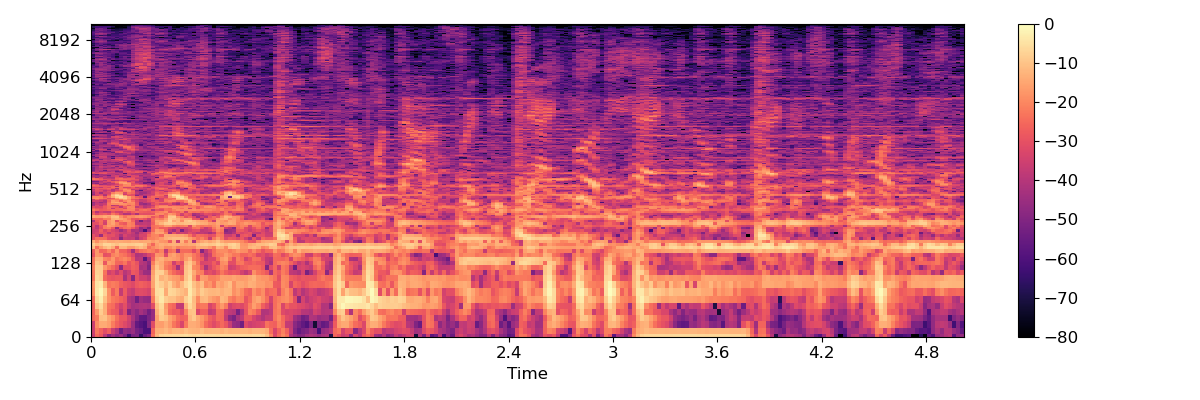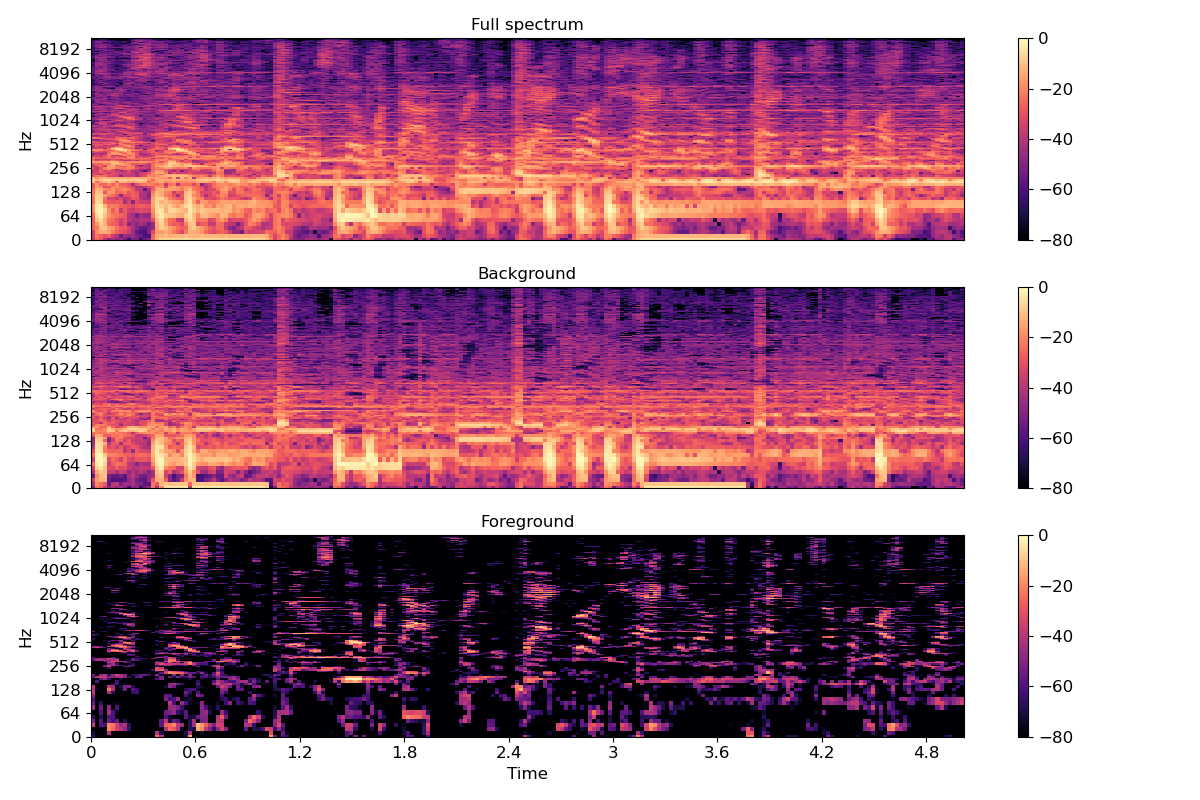Caution
You're reading an old version of this documentation. If you want up-to-date information, please have a look at 0.9.1.
Note
Click here to download the full example code
Vocal separation¶
This notebook demonstrates a simple technique for separating vocals (and other sporadic foreground signals) from accompanying instrumentation.
This is based on the “REPET-SIM” method of Rafii and Pardo, 2012, but includes a couple of modifications and extensions:
FFT windows overlap by 1/4, instead of 1/2
Non-local filtering is converted into a soft mask by Wiener filtering. This is similar in spirit to the soft-masking method used by Fitzgerald, 2012, but is a bit more numerically stable in practice.
# Code source: Brian McFee
# License: ISC
##################
# Standard imports
from __future__ import print_function
import numpy as np
import matplotlib.pyplot as plt
import librosa
import librosa.display
Load an example with vocals.
Out:
/tmp/tmpfl4ra6qp/b0064fe7dbe8048b1d4148e61a568b6fe3fca91b/librosa/core/audio.py:161: UserWarning: PySoundFile failed. Trying audioread instead.
warnings.warn('PySoundFile failed. Trying audioread instead.')
Plot a 5-second slice of the spectrum
idx = slice(*librosa.time_to_frames([30, 35], sr=sr))
plt.figure(figsize=(12, 4))
librosa.display.specshow(librosa.amplitude_to_db(S_full[:, idx], ref=np.max),
y_axis='log', x_axis='time', sr=sr)
plt.colorbar()
plt.tight_layout()

Out:
/tmp/tmpfl4ra6qp/b0064fe7dbe8048b1d4148e61a568b6fe3fca91b/librosa/display.py:862: MatplotlibDeprecationWarning: The 'basey' parameter of __init__() has been renamed 'base' since Matplotlib 3.3; support for the old name will be dropped two minor releases later.
scaler(mode, **kwargs)
/tmp/tmpfl4ra6qp/b0064fe7dbe8048b1d4148e61a568b6fe3fca91b/librosa/display.py:862: MatplotlibDeprecationWarning: The 'linthreshy' parameter of __init__() has been renamed 'linthresh' since Matplotlib 3.3; support for the old name will be dropped two minor releases later.
scaler(mode, **kwargs)
/tmp/tmpfl4ra6qp/b0064fe7dbe8048b1d4148e61a568b6fe3fca91b/librosa/display.py:862: MatplotlibDeprecationWarning: The 'linscaley' parameter of __init__() has been renamed 'linscale' since Matplotlib 3.3; support for the old name will be dropped two minor releases later.
scaler(mode, **kwargs)
The wiggly lines above are due to the vocal component. Our goal is to separate them from the accompanying instrumentation.
# We'll compare frames using cosine similarity, and aggregate similar frames
# by taking their (per-frequency) median value.
#
# To avoid being biased by local continuity, we constrain similar frames to be
# separated by at least 2 seconds.
#
# This suppresses sparse/non-repetetitive deviations from the average spectrum,
# and works well to discard vocal elements.
S_filter = librosa.decompose.nn_filter(S_full,
aggregate=np.median,
metric='cosine',
width=int(librosa.time_to_frames(2, sr=sr)))
# The output of the filter shouldn't be greater than the input
# if we assume signals are additive. Taking the pointwise minimium
# with the input spectrum forces this.
S_filter = np.minimum(S_full, S_filter)
The raw filter output can be used as a mask, but it sounds better if we use soft-masking.
# We can also use a margin to reduce bleed between the vocals and instrumentation masks.
# Note: the margins need not be equal for foreground and background separation
margin_i, margin_v = 2, 10
power = 2
mask_i = librosa.util.softmask(S_filter,
margin_i * (S_full - S_filter),
power=power)
mask_v = librosa.util.softmask(S_full - S_filter,
margin_v * S_filter,
power=power)
# Once we have the masks, simply multiply them with the input spectrum
# to separate the components
S_foreground = mask_v * S_full
S_background = mask_i * S_full
Plot the same slice, but separated into its foreground and background
# sphinx_gallery_thumbnail_number = 2
plt.figure(figsize=(12, 8))
plt.subplot(3, 1, 1)
librosa.display.specshow(librosa.amplitude_to_db(S_full[:, idx], ref=np.max),
y_axis='log', sr=sr)
plt.title('Full spectrum')
plt.colorbar()
plt.subplot(3, 1, 2)
librosa.display.specshow(librosa.amplitude_to_db(S_background[:, idx], ref=np.max),
y_axis='log', sr=sr)
plt.title('Background')
plt.colorbar()
plt.subplot(3, 1, 3)
librosa.display.specshow(librosa.amplitude_to_db(S_foreground[:, idx], ref=np.max),
y_axis='log', x_axis='time', sr=sr)
plt.title('Foreground')
plt.colorbar()
plt.tight_layout()
plt.show()

Out:
/tmp/tmpfl4ra6qp/b0064fe7dbe8048b1d4148e61a568b6fe3fca91b/librosa/display.py:862: MatplotlibDeprecationWarning: The 'basey' parameter of __init__() has been renamed 'base' since Matplotlib 3.3; support for the old name will be dropped two minor releases later.
scaler(mode, **kwargs)
/tmp/tmpfl4ra6qp/b0064fe7dbe8048b1d4148e61a568b6fe3fca91b/librosa/display.py:862: MatplotlibDeprecationWarning: The 'linthreshy' parameter of __init__() has been renamed 'linthresh' since Matplotlib 3.3; support for the old name will be dropped two minor releases later.
scaler(mode, **kwargs)
/tmp/tmpfl4ra6qp/b0064fe7dbe8048b1d4148e61a568b6fe3fca91b/librosa/display.py:862: MatplotlibDeprecationWarning: The 'linscaley' parameter of __init__() has been renamed 'linscale' since Matplotlib 3.3; support for the old name will be dropped two minor releases later.
scaler(mode, **kwargs)
Total running time of the script: ( 0 minutes 28.369 seconds)